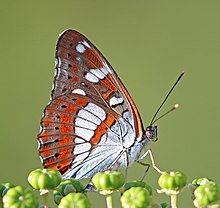Limenitis reducta, the southern white admiral, is a butterfly of the family Nymphalidae.
| Limenitis reducta | |
|---|---|

| |
| Upperside, North Macedonia | |

| |
| Underside, Sithonia, Greece | |
| Scientific classification | |
| Domain: | Eukaryota |
| Kingdom: | Animalia |
| Phylum: | Arthropoda |
| Class: | Insecta |
| Order: | Lepidoptera |
| Family: | Nymphalidae |
| Genus: | Limenitis |
| Species: | L. reducta
|
| Binomial name | |
| Limenitis reducta Staudinger, 1901
| |
| Synonyms[14] | |
|
List
| |
Subspecies
edit- Limenitis reducta reducta Staudinger, 1901
- Limenitis reducta herculeana Stichel, 1909[15]
Distribution and habitat
editThis species can be found in central and southern Europe (northern Iberia, southern and eastern France, Italy, the Balkans, and the Alps),[16] in Western Asia, in Syria, the Caucasus and Iran.[17][18] These butterflies live in light woodland, in woodland glades and in forest edge, at an elevation of 0–1,650 metres (0–5,413 ft) above sea level.[19]
Description
editLimenitis reducta has a wingspan of 46–54 mm.[19] The upperside of the wings is brown black with metallic blue shine, large transversal band of white markings and a submarginal line of small blue dots. The blue sheen varies with the angle of light. The ground colour of underside of the hindwings is red, with a silvery basal area, a row of white markings and a row of black spots. A few white cell spots are also present on the underside of the forewings.[16][19] The caterpillars can reach a length of 27 millimetres (1.1 in). They are light green to dull green on the back, red brown on the underside. On the back there are numerous brown thorns.
This species is rather similar to Limenitis camilla, Neptis rivularis and Araschnia levana f. prorsa.
-
Dorsal side
-
Ventral Side
Biology
editThis species may have one or more generations, depending on the location.[16] The butterfly flies from May to August depending on the location.[19] Larvae feed on honeysuckle (Lonicera periclymenum, Lonicera etrusca, Lonicera implexa, Lonicera xylosteum, Lonicera alpigena, Lonicera nummulariifolia and Lonicera caprifolium).[18] Adults usually feed on nectar of a wide range of herbaceous and arboreal flowers, but also visit fallen fruits, dung, aphid secretions and mineralised moisture from damp ground.[20]
Bibliography
edit- Boulard (Michel), 1988.- Note sur la pariade du Sylvain azuré (Lep. Nymphalidae). Alexanor, 15 (3), 1987 (1988): 156-158.
- D.J. Carter & B. Hargreaves - Guide des chenilles d'Europe - Delachaux & Niestlé, 2012, (ISBN 9782603018460)
- Josef Settele, Roland Steiner, Rolf Reinhardt, Reinart Feldmann: Schmetterlinge. Die Tagfalter Deutschlands., Eugen Ulmer KG, 2005, ISBN 3-800-14167-1
- Tom Tolman, Richard Lewington - Guide des papillons d'Europe et d'Afrique du Nord, Delachaux & Niestlé, Paris 1997 - (ISBN 978-2-603-01649-7)
References
edit- ^ Denis & Schiffermüller, 1775 Ankündung eines systematischen Werkes von den Schmetterlingen der Wienergegend: 172
- ^ Esper, 1778 Die Schmett. Th. I, Bd. 1 (7): pl. 38, f. 2
- ^ Bergsträsser, [1779] Nomen. Ins., 3: pl. 67, f. 5-6
- ^ Miller, 1859 Icon. Lep. 2: pl. 2, f. 1
- ^ Lewis, 1872 Zoologist (2) 7 : 3074 (rej. ICZN-562)
- ^ Grund, 1908 Soc. ent. 23 (11) : 81
- ^ Fruhstorfer, 1909 Int. ent. Zs. 3 (17) : 94
- ^ Niepelt, 1914 Int. ent. Z. 8 (26) : 144
- ^ Lucas, 1923 Amat. Papillons: 50
- ^ Verity, 1924 Ent. Rec. Suppl. 36: 35,
- ^ Verity, 1928 Ent. Rec. 40 : 143
- ^ Higgins, 1933 Proc. R. ent. Soc. Lond. 7: 61
- ^ a b c d Verity, 1950 Le Farfalle diurn. d'Italia 4: 52
- ^ Lepiforum.de
- ^ Limenitis reducta herculeana Stichel, [1909] in Seitz, Grossschmett. Erde 1 : 183
- ^ a b c Euro Butterflies by Matt Rowlings
- ^ Fauna europaea
- ^ a b Funet
- ^ a b c d "Captain's European Butterfly Guide". Archived from the original on 2019-07-22. Retrieved 2017-02-01.
- ^ "Learn about butterflies". Archived from the original on 2017-04-20. Retrieved 2017-02-01.
External links
edit- Lepiforum de
- Lepi Net - Les Carnets du Lépidoptériste Français
- Moths and Butterflies of Europe and North Africa by Paolo Mazzei, Daniel Morel, Raniero Panfili